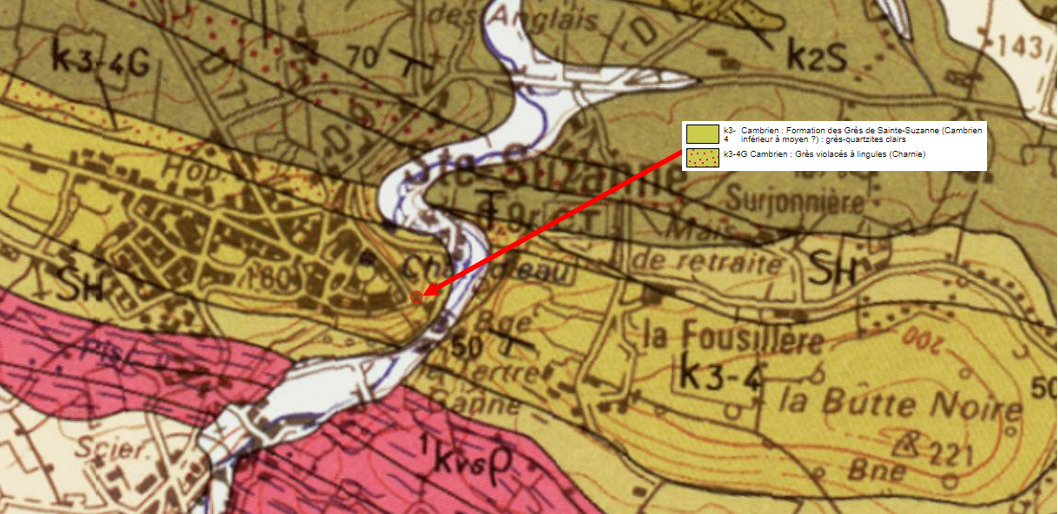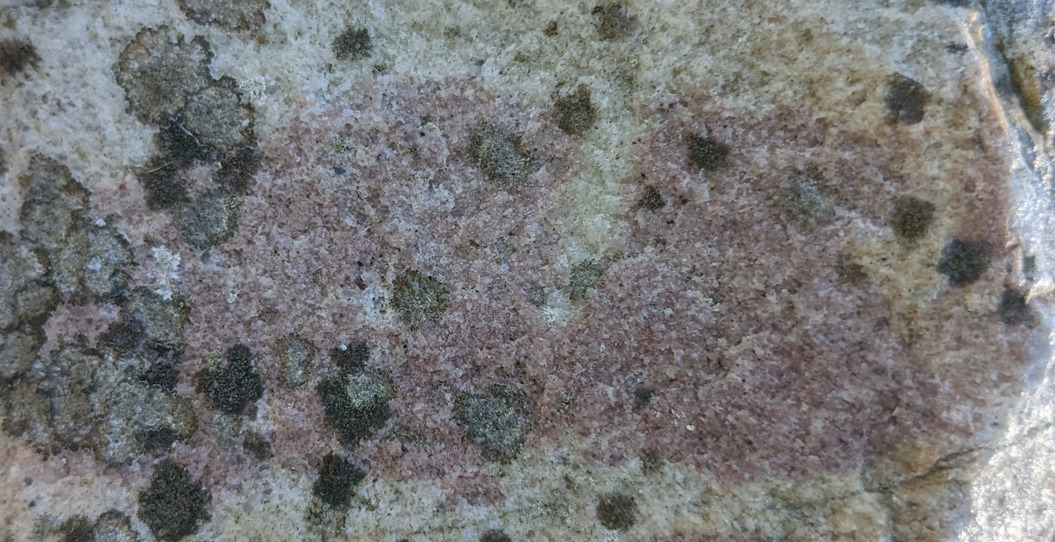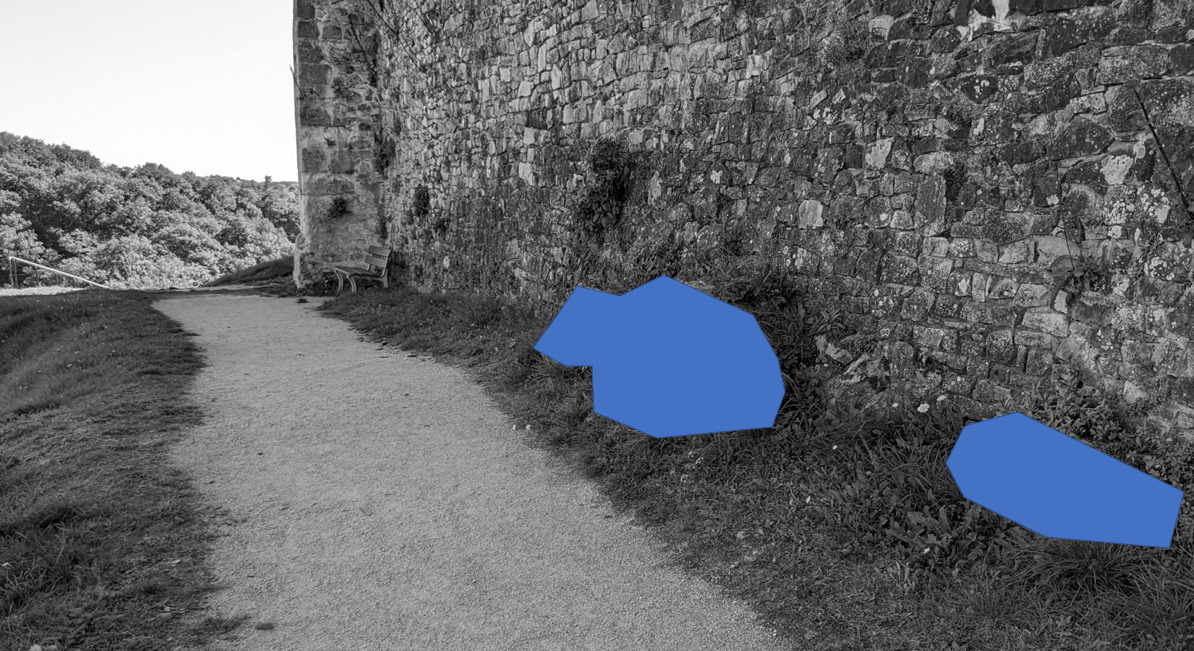
La Earthcache / The Earthcache
► Contexte géologique local
La commune de Sainte-Suzanne est située sur le flanc nord du synclinal de Laval au sein d'un vaste région schisteuse.
Cependant, son point culminant (221 mètres d'altitude), une crête ou est assis le bourg fortifié de Sainte Suzanne, est une particularité géologique dont les caractéristiques expliquent la topographie des lieux et la présence de ce point culminant.
Formée des grès quartzitiques de Sainte-Suzanne, elle permet à la citadelle de dominer toute sa région en en faisant une place forte stratégique depuis l'Antiquité.
A ces pieds, l'Erve s'est frayée un étroit passage d'est en l'ouest.

► Les grès quartzitiques de Sainte-Suzanne
Mise en place au Cambrien inférieur (-480 Ma), il s'agit d'une formation sédimentaire gréseuse faiblement métamorphisée suite aux pressions consécutives à l'orogenèse hercynienne.
Les grains de quartz à l'origine des sédiments, bien calibrés et usés, se sont déposés en milieu marin très littoral avant de se cimenter en un grès, une roche sédimentaire détritique.
Ce grès s'est ensuite sous la pression en partie transformé en quartzite, une roche siliceuse massive constituée de cristaux de quartz soudés.
Ce début de métamorphisation a donné des grains de quartz soudés et non uniquement cimentés. Le fait de frotter la roche ne permet ainsi pas d'en détacher les grains.
Cela en fait une roche beaucoup plus dur qu'un grès sédimentaire, expliquant une résistance beaucoup plus forte à l'érosion que les schistes environnants.
La couleur de ces grès quartzitiques est globalement claire, avec une texture finement grenue.
Nativement grise, la roche prend par endroits une teinte violette particulière due à un concentration spécifique de fer ,la différenciant des couleurs jaunes ou rouges que prend habituellement le fer oxydé dans une roche.

► Local geological context
The commune of Sainte-Suzanne is located on the northern flank of the Laval syncline within a vast shale region.
However, its highest point (221 meters above sea level), a ridge where the fortified town of Sainte Suzanne sits, is a geological particularity whose characteristics explain the topography of the place and the presence of this highest point.
Formed from the quartzitic sandstone of Sainte-Suzanne, it allows the citadel to dominate its entire region by making it a strategic stronghold since Antiquity.
At these feet, the Erve has carved out a narrow passage from east to west.
► The quartzitic sandstones of Sainte-Suzanne
Placed in the Lower Cambrian (-480 Ma), it is a sandstone sedimentary formation that has been slightly metamorphosed following the pressures resulting from the Hercynian orogeny.
The quartz grains at the origin of the sediments, well calibrated and worn, were deposited in a very coastal marine environment before being cemented into a sandstone, a detrital sedimentary rock.
This sandstone was then partly transformed under pressure into quartzite, a massive siliceous rock made up of welded quartz crystals.
This beginning of metamorphization gave grains of quartz welded and not only cemented. The fact of rubbing the rock thus does not make it possible to detach the grains.
This makes it a much harder rock than a sedimentary sandstone, explaining a much stronger resistance to erosion than the surrounding shales.
The color of these quartzitic sandstones is generally clear, with a fine grained texture.
Natively gray, the rock takes on a particular purple hue in places due to a specific concentration of iron, differentiating it from the yellow or red colors that oxidized iron usually takes on in a rock.
► Sources bibliographiques / Bibliographical sources
Les Questions / The Questions
Questions pour valider :"Grès quartzitiques à Sainte Suzanne"
Questions to validate: "Quartzitic sandstone at Sainte Suzanne"
- Question 0 : Prenez une photo de vous ou d'un élément vous appartenant avec la vue sur la vallée de l'Erve en arrière plan.
Cette photo devra au choix nous être transmise avec les réponses ou être ajoutée à votre log.
-Question 0 : Take a picture of yourself or something belonging to you with the view of the Erve valley in the background.
This photo must either be sent to us with the answers or added to your log.
Point 1 : N 48° 05.816 W 000° 20.846'
Suivez la promenade de Poterne en longeant l'extérieur des fortifications jusqu'à un affleurement de roches sous les fortifications de la ville (photo WP1).
Follow the Postern Promenade along the outside of the fortifications to an outcrop of rocks below the city fortifications (photo WP1).

- Question 1 : Décrivez la roche et déduisez en sa nature. Quand vous la frottez, arrivez à enlever des grains ? Essayez aussi de la rayer avec une clef. Comment pouvez-vous qualifier sa résistance face à l'érosion mécanique ? Déduisez en l'impact de cette résistance sur le paysage environnant et sa topographie.
- Question 1: Describe the rock and deduce its nature. When you rub it, manage to remove grains? Also try scratching it with a spanner. How can you qualify its resistance to mechanical erosion? Deduce the impact of this resistance on the surrounding landscape and its topography.
Point 2 : N 48° 05.806 W 000° 20.837
Vous voici devant la porte de la herse où plusieurs types de roches ont été utilisés (photo WP2).
Here you are in front of the portcullis door where several types of rock have been used (photo WP2).

- Question 2 : Les roches de quelles zones ont pu être extraites dans une carrière voisine ?
- Question 2: The rocks of which areas could have been extracted in a nearby quarry?
- Question 2 Bonus : Pour les autres zones, émettez une hypothèse sur la nature de la roche (pas de souci si vous ne trouvez pas, c'est une question bonus).
- Question 2: For other areas, make a guess about the nature of the rock (don't worry if you can't find it, it's a bonus question).
Point 3 : N 48° 05.801 W 000° 20.831'
A l'angle des fortifications, vous pouvez voir un petit affleurement en pointe (photo WP3).
At the corner of the fortifications, you can see a small pointed outcrop (photo WP3).

- Question 3 : Que remarquez-vous sous la zone verte et comment cela s'est-il mis en place ?
- Question 3: What do you notice under the green area and how did it come together?
Vous pouvez vous loguer sans attendre notre confirmation,
mais vous devez nous envoyer les réponses en même temps soit par mail via notre profil (
fafahakkai), soit via la messagerie geocaching.com (Message Center).
S'il y a des problèmes avec vos réponses nous vous en ferons part.
Les logs enregistrés sans réponse seront supprimés.You can log this cache without waiting for our confirmation, but you must send us the answers at the same time, by e-mail via our profile (fafahakkai) or by the system of Message Center of geocaching.com.
If there is a problem with your answers we will notify you. The logs recorded without answers will be deleted.
Rappel concernant les « Earthcaches »: Il n'y a pas de conteneur à rechercher ni de logbook à renseigner. Il suffit de se rendre sur les lieux, de répondre aux questions ci-dessus et de nous renvoyer les réponses.
Reminder concerning "Earthcaches": there is neither a container to look for nor a logbook to sign. One need only go to the location, answer to the differents questions and send us the answers.